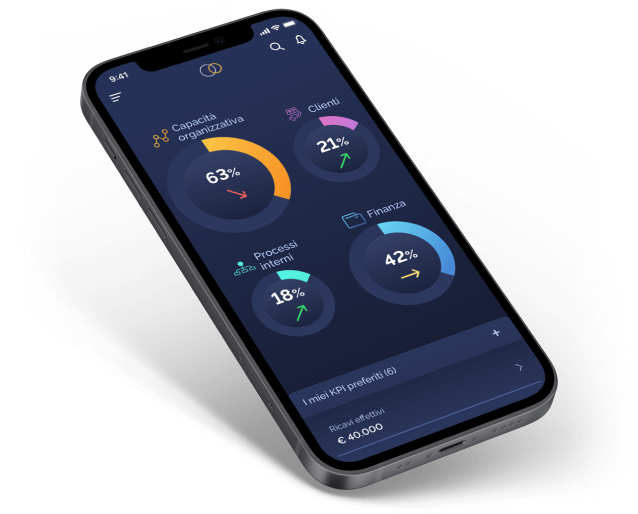
Data, Information, Knowledge, and Wisdom
In 1999, Russell Ackoff, in a visionary anticipation of today’s information society, modeled the data scientist’s activity with a pyramid, defining the “DIKW model”:
- At the base are raw data (Data)
- Through the refinement process, they progressively transform into information (Information)
- Knowledge is derived from this information (Knowledge)
- Forecasting knowledge is processed into wisdom (Wisdom).
However, at least in one significant aspect, Ackoff’s “prophecy” did not come true: wisdom and forecasting ability do not mechanically derive from the lower levels of the pyramid (information and knowledge).
The two fundamental steps, from data to information and from information to wisdom, are “filtered” by people, especially the CEO, and are not automatic. The enormous amount of available data, if not carefully filtered, produces more noise than information.
Information, if not framed in a meaningful context, produces complication and “bad complexity” instead of knowledge. Knowledge with weak and unverifiable foundations leads to disasters.
Wisdom, therefore, does not mechanically derive from knowledge but from the ability to use it profitably. This involves experience, talent, motivation—in short, it’s the CEO’s job.
Unlike in the past, knowledge becomes an increasingly necessary condition, even if not sufficient, to achieve wisdom.
In the movie “A Fistful of Dollars,” at a certain point, the villain Ramon quotes a Mexican proverb: “When a man with a pistol meets a man with a rifle, the man with the pistol is a dead man.” It could be paraphrased: “When a CEO with only intuition meets a CEO who, in addition to intuition, also has information and knowledge, the one with only intuition is a dead CEO.”
Thauma does not presume to replace the CEO’s wisdom, but thanks to its structured framework:
- It transforms scattered information in the ERP (Enterprise Resource Planning) into immediately usable knowledge for the CEO’s work.
- It provides CEOs, even in SMEs, with a useful knowledge base of their organization comparable to that provided by reports from much larger organizations with more administrative and control resources, such as publicly traded companies.
- It does so by using and enhancing an existing investment (ERP) without requiring additional increases in management control spending.
Information and its Many Faces
Henry Mintzberg, a scholar of organizations who seriously investigated what business executives actually do, represented their work on a three-level hierarchy.
- The action level, the foundation for everything else: executives are primarily required to “do,” achieve, produce results.
- The people level: the executive’s “doing” differs from that of a professional because it involves “doing” through “getting others to do.” Executives work in person to ensure their collaborators perform, achieve, and produce results.
- The information level, the most complex (not the “most difficult”) as it requires using information in very different ways: communicating and controlling, processing, and planning.
The CEO’s work level constituted by information is the most complex because the information used for communication could be different from that used for control, processing, and planning, even when representing the same object.
Typical examples of managing the “same” information in different ways:
Communicating and Controlling
Profit margin: a margin is always a difference between revenue and cost. While revenue is (almost) always relatively easy to define (net price multiplied by units sold), the cost can be defined in many ways.
- “Live” Cost: made up of only purchase materials and external processing, something that certainly doesn’t incur if production stops.
- Direct Cost: in addition to the “live” cost, it includes the direct transformation cost (labor, energy, maintenance…), costs that are often incurred, perhaps in reduced measure even if production stops, at least for a short period.
- Industrial Cost: adds general industrial expenses (building depreciation, production management…), costs that are incurred even if production stops for a not short period.
- “Full” Cost: sums the industrial cost and general and commercial expenses (CEO and CFO salaries, advertising, promotion…), costs incurred regardless of production to start and manage the company.
- “Economic-Technical” Cost: also includes the remuneration of equity capital and should be equal to the selling price.
If the CEO wants to provide the sales force with information about the margin, it is reasonable to think that they use either the “full” cost or the “economic-technical” cost. This way, communication has a greater motivating effect to “hold” the price, unlike what would probably happen with the “live” cost.
For a salesperson, seeing that the price is a multiple equal to n times the “live” cost may induce the temptation to grant some discounts beyond what is due.
If the CEO wants to communicate to the production and logistics department what the department’s contribution is to the overall company income, they will use the industrial cost because that is what the function can control, certainly not the items that are outside the area of responsibility.
Process and Plan
If the CEO and CFO are evaluating a choice between the costs of two different production solutions, they will ask for elaborations as accurate as possible, setting aside cautionary markups. Therefore, they will request a very analytical elaboration detail.
Suppose the CEO and CFO are instead financial planning for the cash flows of the next six months (a net cash flow is the difference between “cash” inflows and outflows over a certain period).
In these cases, they will tend to introduce cautionary corrections: if that order doesn’t come in, if that payment is delayed, etc… in planning, they adopt a prudent attitude.
Thauma puts information in the hands of the CEO, constructed in the most objective way possible and then leaves them all the discretion they want in using it in their activities.
Intelligence and the Value of Information. “He Who Snitches Isn’t a Saint”
In a biography of the economist J.M. Keynes, a caustic observation of his is reported: “there is nothing that a ruler hates so much as being well-informed because it makes the process of decision-making much more complicated and difficult”.
Paradoxical, but not too much. It is very likely that the spaces of creativity, intuition, genius, instinct… are inevitably compressed if the problem domain is structured and presented in terms of “perfect knowledge” and therefore solvable, at least in principle, with an algorithm.
In reality, these situations rarely occur, and when they do, their management is delegated to an operative, preferably equipped with appropriate software. At least for CEOs, it is, therefore, a “false problem”.
The most common situation in which a CEO finds themselves is that the most valuable information is the least available (if it is available at all). There is an “inverse law” between the utility and availability of information.
For a CEO, knowing that the CEO of their main customer is having dinner with the CEO of their main competitor would undoubtedly be more useful than seeing a drop in sales months later; knowing that their main competitor is patenting a disruptive innovation would be much more important than detecting that it is increasing its R&D expenses or that their company is increasing R&D expenses.
Unfortunately (or fortunately), as Churchill said: “In war, the truth is so precious that it should always be attended by a bodyguard of lies.” And so it is, at least in part, in business. Without illicit methods, certain confidential information cannot be known.
Therefore, Thauma, being “Digital Performance Intelligence,” does not act as a “snitch”; it simply does “intelligence” within the bounds of the law:
- Observing competitors’ public data.
- Comparing them with the company’s data in a format useful for measuring objectively.
How much are these pieces of information worth? They are a “reminder” that the CEO can always carry with them to remind themselves and their collaborators that:
- A competitive advantage can only be maintained by being proactive, that is, by acting in advance of competitors and the market, anticipating and preventing others’ moves.
- A competitive disadvantage can only be recovered if one commits more than usual. A deficit in some performance is not filled “on its own” but requires targeted initiatives, generally conducted with particular determination.
In general, this can be summarized by remembering what many professionals in informed decision-making, President Luigi Einaudi’s “knowing to deliberate” in his “Useless Preaches,” often repeat and most of the time go unheard: good information is like health; one realizes how precious it is when it is lacking.
To move from the general to the specific, here are some examples of how to use Thauma to get value from information, i.e., performance improvements.
Using Information from Thauma to Improve Performance
Thauma presents itself to the CEO as a tool for continuous stimulation and pressure on oneself and one’s structure to improve performance. Below is a checklist of areas for intervention.
- Increase Revenue
- Cost Reductions
- Reduce Invested Capital
- Anticipate: Avoid Incurring Costs / Revenute Losses (Time)
- Anticipate: Manage Risks (Risk Avoidance, Risk Mitigation)
In this context, the goal is not to indicate specific actions, which require a specific analysis and evaluation of the context. Instead, the aim is to identify, in the most general way possible, areas of potential intervention by the management and encourage quantification using some basic values of the company.
Not all company performances need to be analyzed; it is sufficient to somehow focus on one or two areas of intervention. Then, define and implement the most appropriate organizational and managerial actions.
INCREASE REVENUE
Control systems can yield benefits in revenue growth when information allows activation and action on the following:
- increase the number of customers
- increase sales to individual customers
- increase the value of sales to individual customers (upselling through mix)
- customer loyalty (increase retention)
- price maneuvering.
COST REDUCTIONS
Control systems can yield cost reduction benefits by acting on different levers, depending on whether they are production costs, i.e., direct costs, or general costs (common).
Production Costs – Levers:
- purchase prices
- operational efficiencies
On the price variable, it is possible to act with a Total Cost of Ownership (TCO) approach or differentiated management strategies (e.g., Kraljic matrix). On the efficiency variable, using a combination of organizational and technological tools.
Common Costs:
Typically organizational levers, but different depending on whether costs are “discretionary” or “policy” (training, R&D, advertising) or “structural” (heating, cleaning):
- elimination, reduction, consolidation of activities
- technological interventions.
REDUCE INVESTED CAPITAL
The variables composing it are fixed capital and working capital. Managing fixed capital is typically a strategic variable and is therefore less influenced by information tools focused on the short-medium term.
Today, for many capital assets, the alternative of buying/leasing is available and should always be considered whenever the asset is not strategic and therefore specific. Generally, working capital is more subject to short-term management action. It is broken down into:
- Accounts Receivable
- Accounts Payable
- Inventory
Commercial or supply-related receivables/payables – Two variables can improve cash flow: receivables from customers and payables to suppliers. The levers include:
- Negotiation levers: depend on the company’s bargaining power in the exchange chain and are generally a zero-sum game (what one actor gains is the other’s loss); and involve shortening collection terms and extending payment terms, having inventory financed by the supplier.
- Operational levers: those with a non-zero sum, such as restructuring purchasing/selling methods, tight control of compliance with terms.
Inventory – Unlike supply-related debts and credits, inventory is subject to interventions of various nature and scope, with a multitude of approaches, including those of lean production:
- reduction of lots and increased turnover
- reduction of setups
AVOID INCURRING COSTS / REVENUE LOSSES (TIME)
Anticipating a certain decision can lead to the benefit of not incurring certain costs or obtaining certain revenues. This is possible by looking ahead, planning, and with a bit of luck. The opposite happens if decisions are made late: inertial costs continue to be incurred and/or revenues are missed. Typical cases of “avoidance” include:
- Costs: Anticipating an increase in supply prices with an early purchase or framework contract.
- Revenues: Anticipating a list price increase in the face of an increase in input prices.
RISK AVOIDANCE (TIME)
Typically the subject of management policies, whose early implementation prevents risks from materializing. In this case, the beneficial impact occurs if decisions made and implemented in advance succeed in preventing and avoiding the event. Typical examples include:
- Preventing the default of a customer/supplier to avoid losses on receivables or damages from supply interruptions.
- Preventing the loss of critical customers.







